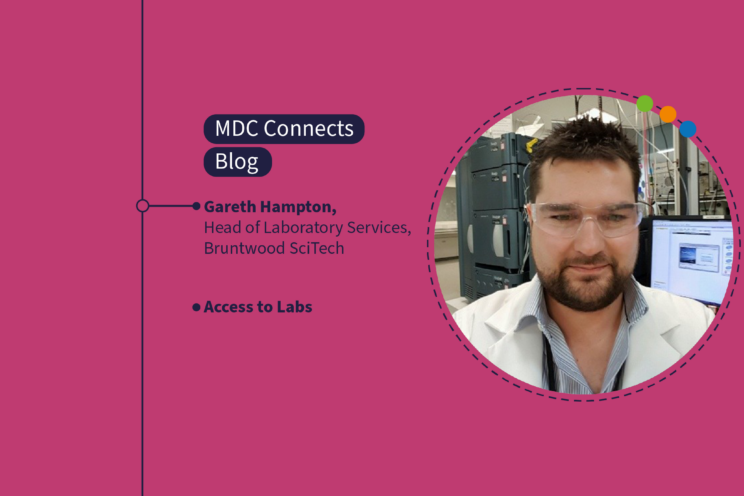Access to Labs
With availability limited and lab facilities not evenly spread across the UK, it is important to make well-informed decisions on the kind of lab space you need early on, because these choices can have consequences further down the line.
By Gareth Hampton
24 July 2024


Right Lab, Right Time
With availability limited and lab facilities not evenly spread across the UK, it is important to make well-informed decisions on the kind of lab space you need early on, because these choices can have consequences further down the line.
Accessing the right lab at the right time on your drug discovery journey is also key to sound planning. Paying careful consideration to these factors may even bring into question whether you really need any in-house lab facilities.
This blog explores the important questions around lab access, and how to navigate the sector to find the best solution.
What is a Wet Lab?
Going back to basics, it is worth defining what a wet lab constitutes. Primarily, these facilities should provide an environment that keeps people and experiments safe. Clearly this covers adequate provision for the containment of hazards and protection against contamination.
Beyond the ‘baseline’ features applied to all labs, the specifics of processes to be performed will dictate the additional equipment and precautions required.
Again, in basic terms, it is important to determine if your research will require hazard containment, or is protecting against contamination from external sources the most crucial factor.
A Typical Wet Lab
There is no one standard definition of a wet lab, but certain features are common to most:
- IP65 rated light fittings and wipe-clean ceilings
- Local exhaust ventilation, for example, fume cupboards
- Benches and surface finishes impervious to chemicals
- Heating, ventilating and air conditioning (HVAC) system
- Hand wash basin
- Containment provision, and services including power, data and gases
The ‘typical’ lab description can also be broken down by scientific discipline, each having specific requirements in terms of safety and control of external contaminants:
- Chemistry – for example, pharma, chemical manufacturing, agro chemicals
- Biology – strongly focused on hazard management
- Analytic/analysis
- Research (usually medical or clinical), often found in hospital, pharma and CRO settings
- Clean rooms
The Size and Type of Lab
Early-stage drug discovery companies often start in a shared lab and move on through increasingly larger spaces if required. The premises-type progression usually follows the growth of a company, so a spin-out starts with co-working space, moving through serviced premises to leased, then at the established corporate level, its own purpose-built facilities, for example.
Containment Regulations
Containment is a leading concern in lab work; in the UK regulations comprise four levels of containment specifications. The materials a given drug discovery process uses must be matched to a lab equipped to handle the appropriate level of containment.
Level 1 (CL1) – intended for deliberate work with micro-organisms and genetically modified organisms with a nil or negligible risk to humans or the environment.
Level2 (CL2) – for deliberate work with micro-organisms and genetically modified organisms that could potentially cause disease in humans or harm the environment.
Level 3 (CL3) – for deliberate work with micro-organisms and genetically modified organisms that could potentially cause severe disease in humans or harm the environment.
Level 4 (CL4) – appropriate for work with extremely dangerous pathogens that could easily be aerosol-transmitted within the laboratory, and cause severe-to-fatal disease for which there are no available vaccines or treatments.
The Health & Safety Executive website gives more information on each of the containment levels.
More sophisticated, specialist equipment is required at the higher risk levels – generally, costs of lab space increase and availability diminishes the more containment is required.
It is advisable to consult with a relevantly experienced safety consultant if you envisage working with CL3 or CL4 level materials.
Shared Lab Space
An ideal option for early-stage organisations working in drug discovery, often found in universities and science park incubators. There are of course, pros and cons to consider:
Advantages
-
-
- Usually fixed monthly cost
- Flexible access to specialised lab equipment
- Access to state-of-the-art equipment
- Lab manager/staff support
- Hazardous waste disposal included
- Collaboration opportunities
- Often part of a supportive ecosystem – in a science park setting, for example
-
Disadvantages
-
-
- Activities can be restricted
- The need for liaison to fit with other users’ requirements
- A busy and sometimes chaotic environment
- Reliance on other users to maintain ‘good housekeeping’
- Additional SHE considerations
- Additional training and documentation required
-
Serviced Labs (Incubator Labs)
Usually modular small labs that are typically the next step from shared facilities.
Advantages
-
-
- Less capital cost
- Dedicated lab space
- Simpler SHE control considerations
- Often provide communal breakout space
-
Disadvantages
-
-
- Typically small footprint spaces
- Less access to shared lab equipment
- More expensive than shared space
- Usually less flexible lease terms
-
Biology CL1, CL2 and Chemistry Labs
Generally fully fitted out and ready for work, designed by the operator or previous owner.
Advantages
-
-
- Ready to occupy, cheaper than designing a lab from scratch
- Usually larger than serviced labs
- Dedicated write-up space
- Dedicated lab space – secure and easier management of SHE
- Longer leases
- Simpler SHE – giving scope for more hazardous work
-
Disadvantages
-
-
- Limited availability
- Designed and built to generic requirements or those specific to the previous user
-
Bespoke Labs
Established organisations will often have the resources to design and build their own bespoke lab spaces. In this case careful consideration needs to be given to several important factors – including future-proofing:
-
-
- Current and projected staff numbers
- Provision of different functional areas – chemistry, biology, cell culture, clean rooms, for example
- How safety regulations will impact space allocations – now and in future
- Up-to-date equipment schedule, including space requirements, power outlets, plumbing, etc
- Specialist requirements – gases, equipment or materials
- Business-critical items
- Readiness to accommodate regulatory changes as activities evolve
- Storage requirements
-
In summary
For early-stage innovators, lab space clearly needs to be affordable on limited budgets, and easy to access. These organisations will often find a science park provides the flexible, economic facilities they require, along with multi-faceted support beyond simply providing suitable labs.
The science park ecosystem also stimulates networking with like-minded companies, knowledge sharing, opportunities to benefit from others’ experience, business support, accelerator programmes and more.
In an environment where lab space is limited and often clustered in certain areas, science parks are numerous and more evenly distributed across the UK. Bruntwood SciTech offers bespoke, fully-fitted CL1, CL2 and Chemistry labs, alongside Coworking labs across Manchester, Cheshire, Birmingham and Cambridgeshire, with space available now.
Gareth Hampton, Head of Laboratory Services, Bruntwood SciTech



